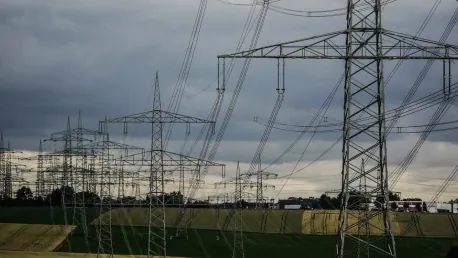The governors of Delaware, Illinois, Maryland, New Jersey, and Pennsylvania have jointly urged PJM Interconnection to recalibrate its capacity market rules and streamline its interconnection queue process. This call to action arrives in response to the staggering $14.7 billion projected cost for consumers from PJM’s latest capacity auction. There’s growing concern that such exorbitant costs could stifle economic growth in the region. By reevaluating these mechanisms, the governors hope to create a more efficient and economical energy capacity development landscape.
Governors’ Concerns Over PJM’s Interconnection Process
Inefficiencies Hinder Capacity Development
One of the primary concerns among the governors is the inefficient and protracted interconnection process managed by PJM, which significantly hinders the development of additional energy capacity. This frustrating bottleneck makes it considerably difficult for new energy projects to come online swiftly, impeding the much-needed growth in the energy sector. The governors argue that unless developers can navigate the interconnection queue with greater speed, high capacity prices will fail to incentivize the desired growth in energy capacity projects. As a result, consumers end up bearing the burden of excessive costs without gaining the benefits of increased energy capacity.
Several delays and red tape within PJM’s current system exacerbate these inefficiencies, driving the final costs even higher. The governors believe that reforming this elongated process is critical to achieving timely project completion and maintaining the economic vitality of their respective states. Without meaningful changes, the existing slow pace will continue to stymie not only the energy market but also broader economic growth, keeping consumers weighed down by skyrocketing costs. Addressing these inefficiencies is seen as a fundamental step toward fostering a robust and dynamic energy market that responds adeptly to both demand and opportunity.
Call for Expedited Review Process
In light of these challenges, the governors are advocating for a more expedited review process capable of accelerating the deployment of new energy projects significantly. They stress that this speedup is essential, irrespective of fluctuating prices, to ensure energy capacity development aligns with rising consumer demand and market necessities. Accelerating the review process could pave the way for improved economic growth by facilitating quicker completions of energy projects, thereby meeting regional needs more effectively.
An expedited queue not only helps meet immediate energy needs but also promotes a competitive market that attracts investment and innovation. Quicker project approvals can provide developers with the confidence needed to plan and implement new ventures without the fear of protracted delays, which often diminish the viability and financial appeal of their projects. The governors emphasize that these reforms are not just about speeding up processes but also about making the energy market more agile and adaptable to the dynamic requirements of the region’s economy.
Support for Auction Delay and Market Rule Changes
Stakeholder Engagement Period
In alignment with PJM’s plan to delay the upcoming capacity auction by six months, the governors emphasize the need for this hiatus to allow for critical stakeholder engagement. This period will be essential for implementing significant market rule changes. Understanding the complexity and significance of the proposed reforms, the governors underscore that a thoughtful and inclusive engagement with stakeholders is vital for achieving a comprehensive and effective overhaul of the current system. The delay is seen as a necessary step to recalibrate the market beneficially for all players involved.
This stakeholder engagement period offers a platform for nuanced discussions and negotiations among diverse parties, including utilities, regulators, environmental groups, and consumer advocates. It is an opportunity to build a consensus on changes that can alleviate the pressing issues plaguing the current market framework. The governors assert that taking this time to ensure well-rounded input from all relevant stakeholders will lead to more sustainable and effective policy adjustments, ultimately fostering a more reliable and consumer-friendly energy market.
Wide-Ranging Support for Reform
Various groups, such as the Organization of PJM States, Inc. (OPSI), PJM’s independent market monitor, and the PJM Power Providers Group (P3 Group), have joined the governors in supporting these reforms. The collaborative stance underscores the urgent need to address these market inefficiencies and mitigate excessive costs that ultimately burden consumers. This alliance highlights the wide-ranging acknowledgment across different sectors of the critical need for timely and effective market reforms.
The involvement of these diverse groups points to a shared recognition that PJM’s current capacity market framework is less than optimal and ripe for change. By pooling resources and expertise, these stakeholders aim to create a unified push toward achieving a recalibrated market that strikes a balance between reasonable consumer costs and efficient energy capacity growth. The broad-based support reflects a collective determination to address systemic issues and implement solutions that are robust and forward-thinking, ensuring that the reformed market can adapt to future demands and challenges.
Recommendations to Curtail Excessive Costs
Revising Reliability Must-Run (RMR) Units’ Rules
Environmental groups, such as the Sierra Club, have voiced strong concerns regarding PJM’s Reliability Must-Run (RMR) units’ rules, which they claim unjustifiably inflate capacity prices. The governors have echoed these complaints, suggesting that revising these rules could lead to significant consumer savings ranging between $3 billion to $5 billion in future auctions. This proposed revision aims to maintain market competitiveness while sending more accurate price signals to developers and investors, encouraging them to make well-informed and economically viable decisions.
Modifying the RMR rule framework will, therefore, cut down on unnecessary expenses, making the capacity market fairer and more transparent. The focus on rule revisions underscores the need for a balanced approach that considers both grid reliability and cost efficiency. By addressing the flaws in the current RMR rules, the governors are pushing for a more equitable marketplace that benefits consumers and supports a balanced distribution of energy resources. The ultimate objective is to create a sustainable and economically viable energy market that serves the best interest of all stakeholders involved.
Eliminating Must-Offer Exemption and Protecting Intermittent Resources
Another crucial recommendation is the removal of the must-offer exemption for intermittent resources. However, the governors underscore the importance of shielding these resources from penalties that might otherwise deter their market participation. This balanced approach aims to encourage broader engagement in the capacity market, ensuring a wider array of energy sources is utilized. By creating a more inclusive market environment, the governors hope to promote diversity in energy resources, which in turn can contribute to greater energy resilience and stability.
The proposed measures to eliminate exemptions are designed to foster a level playing field where all resources can compete fairly and contribute to the grid’s capacity requirements. Protecting intermittent resources, such as wind and solar, from penalties ensures that their valuable contributions are not undermined by punitive measures that could stifle innovation and deployment. The combination of strict entry requirements with protections against unreasonable penalties exemplifies a strategic approach to market reform that aims to harness the full potential of various energy sources while safeguarding against the risk of market distortions.
Adjusting Market Mechanics for Stability
Reducing Capacity Price Caps
The governors are also advocating for lowering capacity price caps back to pre-reform levels. They argue that reducing these caps is essential to alleviate the financial burden on consumers while still ensuring that the market remains competitive and attractive to investors. By lowering these caps, they aim to strike a balance between affordability and the need to foster a robust investment environment that supports continual growth and innovation within the energy sector. Reducing capacity price caps could offer immediate relief to consumers grappling with high energy costs while laying the groundwork for long-term market stability.
Such a move could signal to investors that the market is both fair and predictable, thus encouraging more significant capital inflows into new energy projects. Lowered price caps would provide clarity and reliability, making it easier for businesses and consumers to plan their energy needs and expenditures. In the context of broader market reform, reducing capacity price caps is viewed as a prudent step to ensure the overall health of the energy market, promoting sustained economic growth and competitiveness.
Revising Effective Load Carrying Capability (ELCC)
Reviewing and refining the Effective Load Carrying Capability (ELCC) accreditation process is another pivotal recommendation from the governors. They emphasize that enhancing the accuracy and reliability of ELCC metrics will help better gauge capacity contributions from various resources, thus fostering a more balanced and efficient market. By revisiting the ELCC methodology, the aim is to ensure that each resource’s actual contribution to grid reliability is accurately represented, which can lead to more informed decision-making by both policymakers and market participants.
Improved ELCC accreditation can also facilitate the integration of newer, renewable technologies that might have been undervalued under the current system. Addressing shortcomings in ELCC assessments can lead to a more comprehensive understanding of resource capabilities, thereby encouraging the deployment of innovative solutions that can meet future energy needs effectively. The governors advocate for a transparent and scientifically grounded approach to ELCC, which can serve as a cornerstone for meaningful capacity market reforms aimed at long-term sustainability and reliability.
Adopting a Subannual Capacity Market
Finally, the governors propose implementing a subannual capacity market as a method to mitigate transmission system risks in a more distributed and manageable manner. This change could provide more granular control and responsiveness to shifting energy needs throughout the year. The adoption of a subannual market is intended to address the dynamic nature of energy demands and the corresponding supply requirements, ensuring that grid reliability is maintained without imposing excessive costs on consumers.
A subannual capacity market can allow for more frequent adjustments and refinements, reflecting real-time conditions more accurately than annual assessments. This granular approach enables a more responsive and adaptive market structure that can deal swiftly with emerging issues and opportunities. By breaking down capacity commitments into shorter timeframes, the market can better accommodate the fluctuations in demand and supply, enhancing overall system efficiency and reliability. The governors believe that such a system will lead to a more resilient energy market capable of meeting both current and future challenges.
The Role of States and Potential Investments
Facilitating Shovel-Ready Projects
The governors highlight the potential for states to play an active role via PJM’s Reliability Resource Initiative, facilitating the identification of “shovel-ready” projects. By expediting their own interconnection reviews, states can significantly contribute to creating a more robust and reliable energy grid. The focus on shovel-ready projects is to ensure that those projects with immediate potential for implementation do not languish in bureaucratic red tape, thereby optimizing the use of available resources and accelerating capacity growth.
State involvement in streamlining interconnection processes and prioritizing shovel-ready projects can lead to faster and more effective deployment of energy solutions. This proactive approach by states not only complements PJM’s broader reform efforts but also leverages local insights and capabilities. By identifying and fast-tracking projects that are already primed for development, states can play a crucial role in addressing capacity shortfalls, enhancing grid reliability, and supporting economic growth within their jurisdictions.
Attracting Capital Investments
The governors of Delaware, Illinois, Maryland, New Jersey, and Pennsylvania have banded together to urge PJM Interconnection to revise its capacity market rules and simplify its interconnection queue process. This collective call stems from a projected $14.7 billion cost to consumers arising from PJM’s latest capacity auction. The staggering financial burden has raised alarms about potentially hindering economic growth throughout the region. The governors believe that by reevaluating these market mechanisms, they can pave the way for a more efficient and cost-effective energy capacity development framework. Their aim is to foster a system that not only ensures reliability but also promotes affordability. This initiative is critical in balancing the demands of the energy market with the economic well-being of consumers. The current capacity market’s complex regulations and high costs have sparked a pressing need for reform. By bringing attention to these issues, the governors hope to inspire changes that could lead to a more sustainable and economically viable energy future for their states.









